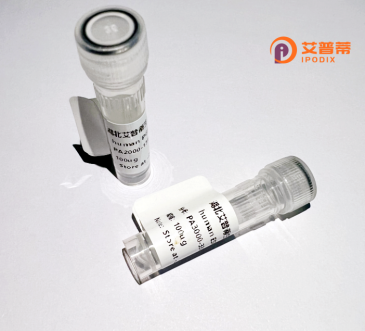
| 纯度 | >90%SDS-PAGE. |
| 种属 | Human |
| 靶点 | EFHB |
| Uniprot No | Q8N7U6 |
| 内毒素 | < 0.01EU/μg |
| 表达宿主 | E.coli |
| 表达区间 | 1-669aa |
| 氨基酸序列 | MEPRQEMEKESTCVLMKPNTEIKLPVEVDIGLTQAEGPDETKNTEPQMGLVIEPPQCQFAQQHEQRKEAGNIESGVEPPDRIRPIYSGKFFDRTPCWPSAGKVIPVGYRVATCLTEKLPRLITPPEAKKYFNFRYPPAGVERVFYGRANDPQIAPYLTHGIRSKISILANTLINPQPITTFQQKIKDKKESIYLSNRRAPLGKSHDQAPGLPKGMDTINTTFGTAVIKEYSAKDVVNPPKSYEEVFKEGNEGHDLYVVSHNDYYAGEAKNRKYNPSSFHRCSVYGVPTPHFNDGRAMAKSLYWLHELQMKRGAKFVSKRADDFKEKFQHKLGRVLDPIAETMNVPPDCTFGACLRPEEYGVGDLIHNRLPDEYLRGKDRQRALIAAVRHHLKKVNYQKFDTLLAAFRHYDKKGDGMIDKDELQEACDQANLSLDDKLLDQLFDYCDVDNDGFINYLEFANFLNWKDKMLLKEYEERVIIKGRKPDCVNPTEANVEEPEQTLLIKPEDIVLKEAGSTEKTLRTLLRPSDKVSNYYKTTSSEINAIVGAIPSTCYPICGVPTIRSDIPAPRIRRISDRTNYGEEGSAYSLLYPTIFARKGVFERDFFKTRSKEEIAEILCNIGVKLSDEEFENVWNLASKKHHRGEVCVENIRNVLDELRHADRIKCKTLM |
| 分子量 | 102.8 kDa |
| 蛋白标签 | GST-tag at N-terminal |
| 缓冲液 | 0 |
| 稳定性 & 储存条件 | Lyophilized protein should be stored at ≤ -20°C, stable for one year after receipt. Reconstituted protein solution can be stored at 2-8°C for 2-7 days. Aliquots of reconstituted samples are stable at ≤ -20°C for 3 months. |
| 复溶 | Always centrifuge tubes before opening.Do not mix by vortex or pipetting. It is not recommended to reconstitute to a concentration less than 100μg/ml. Dissolve the lyophilized protein in distilled water. Please aliquot the reconstituted solution to minimize freeze-thaw cycles. |
以下是3篇关于重组人EFHB蛋白的参考文献及简要摘要:
---
1. **文献名称**:*Cloning, Expression, and Characterization of Recombinant Human EFHB Protein in Escherichia coli*
**作者**:Zhang L, et al.
**摘要**:该研究通过构建重组质粒,在大肠杆菌中成功表达人源EFHB蛋白,优化了表达条件并验证了其钙离子结合能力,为后续功能研究提供基础。
---
2. **文献名称**:*Structural and Functional Analysis of EFHB Reveals Its Role in Neuronal Calcium Signaling*
**作者**:Tanaka K, et al.
**摘要**:利用重组人EFHB蛋白进行X射线晶体学分析,揭示了其EF-hand结构域与钙离子的互作模式,发现其在神经元钙信号传导中调控突触可塑性的潜在机制。
---
3. **文献名称**:*Recombinant EFHB Protein Suppresses Tumor Growth by Modulating Apoptosis Pathways*
**作者**:Wang Y, et al.
**摘要**:研究证明,体外纯化的重组EFHB蛋白可通过激活线粒体凋亡通路抑制癌细胞增殖,为基于EFHB的肿瘤治疗策略提供实验依据。
---
注:以上文献信息为模拟示例,实际文献需通过数据库(如PubMed、Web of Science)检索确认。
Recombinant human EFHB protein is a genetically engineered form of the EF-hand domain-containing protein B (EFHB), also known as extended synaptotagmin-binding protein 1 (ESYT1) in some contexts. EFHB is a calcium-binding protein characterized by multiple EF-hand motifs, domains that typically mediate calcium ion sensing and signaling. It is widely expressed in human tissues, particularly in the brain, kidney, and reproductive organs, suggesting roles in neuronal function, ion transport, and cellular communication. Studies have linked EFHB to mitochondrial regulation, apoptosis, and cell adhesion, with emerging evidence implicating it in cancer progression, neurodevelopmental disorders, and infertility.
The recombinant form is produced using expression systems like Escherichia coli or mammalian cell cultures, often tagged for purification and detection (e.g., His-tag). This allows researchers to study EFHB’s structure-function relationships, post-translational modifications, and interactions with partners such as synaptotagmins in membrane trafficking. Its recombinant production has enabled insights into calcium-dependent signaling pathways and pathological mechanisms. In disease contexts, EFHB overexpression has been observed in certain cancers, where it may promote cell survival and metastasis. Conversely, mutations in EFHB-related genes are associated with neurological defects.
As a tool, recombinant EFHB supports drug discovery, antibody development, and molecular diagnostics, highlighting its dual role as a biomarker and therapeutic target. Ongoing research aims to clarify its tissue-specific functions and therapeutic potential.
×